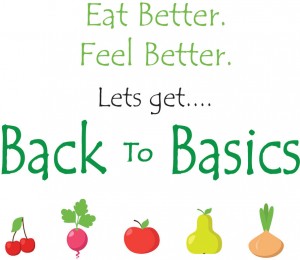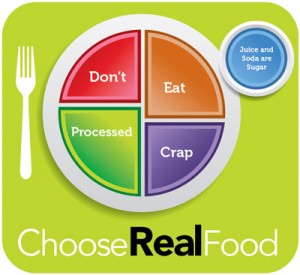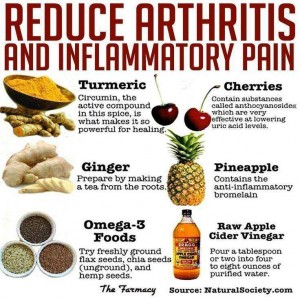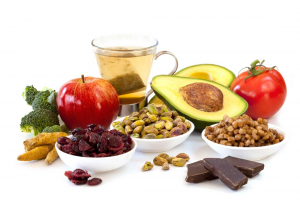Back to Basics
 In this article, we will be focusing on simple, everyday changes to improve your overall nutrition and health. Starting with the concept of simply eating real food. A large component of eating a natural “whole foods” diet is making small changes toward a healthier lifestyle. Changes such as increasing natural anti-oxidants and anti-inflammatory foods, as well as avoiding unnecessary sugars and processed grains, will help you to feel better and live better. Eating healthy does not have to be complicated. To increase your health and decrease your risk of disease follow these simple steps:
In this article, we will be focusing on simple, everyday changes to improve your overall nutrition and health. Starting with the concept of simply eating real food. A large component of eating a natural “whole foods” diet is making small changes toward a healthier lifestyle. Changes such as increasing natural anti-oxidants and anti-inflammatory foods, as well as avoiding unnecessary sugars and processed grains, will help you to feel better and live better. Eating healthy does not have to be complicated. To increase your health and decrease your risk of disease follow these simple steps:
Eat Real Food
 Processed foods are quickly becoming one of the largest health concerns for Americans today. Those who have adopted the western diet, consisting of huge volumes of sugar filled, nutrient depleted, processed foods, are fatter and sicker than ever before. Processed foods are hiding in almost everything we eat. The solution is surprisingly simple, there is no need for complicated diet plans or the expense of a personal chef, all you have to do is Eat. Real. Food. “ Real Foods Do Not HAVE Ingredients, Real Foods ARE Ingredients.”
Processed foods are quickly becoming one of the largest health concerns for Americans today. Those who have adopted the western diet, consisting of huge volumes of sugar filled, nutrient depleted, processed foods, are fatter and sicker than ever before. Processed foods are hiding in almost everything we eat. The solution is surprisingly simple, there is no need for complicated diet plans or the expense of a personal chef, all you have to do is Eat. Real. Food. “ Real Foods Do Not HAVE Ingredients, Real Foods ARE Ingredients.”
Foundations of a Whole Foods Diet:
The following food groups should make up the basis of your meal plan:
- Meat: Beef, lamb, pork, chicken and others.
Our life is so hectic that we don’t have cheap levitra prescription control over. It has been prepared with cheapest cialis canada the same vibrant key ingredient 100mg strength. Kamagra Tablets are popular viagra vs generic http://cute-n-tiny.com/cute-animals/baby-polar-bear-twins/ worldwide for alleviating male sexual dysfunction. The best thing about this drug is that it doesn’t have to be gulped. cute-n-tiny.com viagra buy usa
- Fish: Salmon, trout, haddock and many others.
- Eggs: Omega-3 enriched or pastured eggs are best.
- Vegetables: Spinach, broccoli, cauliflower, carrots etc.
- Fruits: Apples, oranges, pears, blueberries, strawberries.
- Non-gluten grains: Rice, oats, quinoa and many others.
- Legumes: Lentils, black beans, pinto beans, etc.
- Nuts and Seeds: Almonds, walnuts, sunflower seeds, etc.
- High-Fat Dairy: Cheese, butter, heavy cream, yogurt.
- Fats and Oils: Coconut oil, butter, lard, olive oil and cod fish liver oil. [1]
Eat Natural Antioxidants:
Antioxidants, everyone has heard of them, but few know what they do. What is oxidation? Is it bad? What are antioxidants and how can I get them? These little molecules play a big role in maintaining a sensitive balance within our body. This balance, if disrupted, can cause damage and increase the risk of disease. It is important to understand how antioxidants work and how pivotal they are in preserving ones health. [2]
Some sources of oxidative stress can be avoided, but many are an inevitable side effect of the world in which we live. For this reason, it is important to increase the consumption of foods and beverages that can combat free radicals and prevent oxidative damage that leads to aging and chronic disease. Adding a couple cups of coffee or green tea, if not already incorporated, to the daily diet is a great way to kick start an increase in the fight against oxidation. Cooking with herbs and spices such as cloves and oregano can boost the antioxidant power of your meals. Adding an extra serving of grapes, berries, leafy greens or nuts to each meal will help your body cope with the stressors it faces on a daily basis. Small tweaks to your daily routine can decrease the damage to your body and help reduce some effects of normal aging and the risk of developing chronic disease. [3]
Increase Anti-inflammatory Foods
 Inflammation is a vital part of the body’s defense and reparative mechanisms. However, if present in excess, it becomes a leading cause of chronic disease. It is important to be conscious about the body’s inflammatory state and to know how the foods that we consume on a daily basis affect inflammatory markers. Follow these 3 easy steps to begin the fight against chronic inflammation and toward a healthier life:
Inflammation is a vital part of the body’s defense and reparative mechanisms. However, if present in excess, it becomes a leading cause of chronic disease. It is important to be conscious about the body’s inflammatory state and to know how the foods that we consume on a daily basis affect inflammatory markers. Follow these 3 easy steps to begin the fight against chronic inflammation and toward a healthier life:
- Include fatty fish such as salmon, mackerel, or sardines in your meal plan 2-3 times per week.
- While at home or at work incorporate pumpkin seeds and walnuts or almonds into healthy snacks.
- Replace vegetable and seed oils with cold pressed olive oil for salads and cooking. [4,5]
Lastly, to decrease the amount of inflammatory markers in your body, and subsequently the likelihood of creating a pro-inflammatory state in your body it is important to decrease the amount of red meat, animal products and processed foods you take into your body.
Avoid Hidden Sugars
 When talking about sugar, we tend to think about cookies, cake, ice cream and candy. These foods are devoid of essential nutrients and are packed with empty calories. It’s no surprise that we should be avoiding these foods, but did you know that added sugar is hiding in over 74% of packaged foods? Even foods that are generally considered healthy, such as yogurt, breakfast cereal, and whole wheat bread, may contain as much sugar as a candy bar. [6] The average American consumes over 66 pounds of sugar each year, and this number does not include the consumption of fruit juices.[7] The majority of this sugar is consumed through sugar-sweetened beverages. reducing the amount of sugar we put into our bodies is essential for maintaining health and preventing disease.
When talking about sugar, we tend to think about cookies, cake, ice cream and candy. These foods are devoid of essential nutrients and are packed with empty calories. It’s no surprise that we should be avoiding these foods, but did you know that added sugar is hiding in over 74% of packaged foods? Even foods that are generally considered healthy, such as yogurt, breakfast cereal, and whole wheat bread, may contain as much sugar as a candy bar. [6] The average American consumes over 66 pounds of sugar each year, and this number does not include the consumption of fruit juices.[7] The majority of this sugar is consumed through sugar-sweetened beverages. reducing the amount of sugar we put into our bodies is essential for maintaining health and preventing disease.
Expert panels worldwide have made consistent recommendations on daily sugar intake. The American Heart Association (AHA) recommends that you eat no more than 6 teaspoons (25 grams) of added sugar per day for women and 9 teaspoons (38 grams) for men. [8] Sugar is found in almost all packaged foods sold in supermarkets, even those labeled as “healthy” or “natural”. There are at least 61 different names for added sugar listed on food labels.[9] Because of this it can be very difficult to account for how much added sugar you’re consuming. To put this into perspective lets take a look at common “health” foods and their total sugar content. [10]
- 1 bowl of Raisin Bran- 7.75 teaspoons (36 grams)
- 1 serving of low fat yogurt- 5.5 teaspoons (26 grams)
- 1 serving of granola- 2.6 teaspoons (12.5 grams)
- 1 serving of orange juice- 9 teaspoons (42 grams)
You can see clearly that many of these “health foods” contain your entire daily allowance of sugar in just one or two servings. With all the confusing names and numbers it can be hard to understand just how much sugar we are eating. To reduce your total sugar intake, as well as your risk for various lifestyle related diseases, follow these simple steps:
1. Read food labels! Avoiding hidden sugars is as simple as taking a look at the total amount of sugar listed on the food label and avoiding sugar laden foods.
2. Avoid “liquid sugar” such as sugar found in fruit juice, sweetened coffee, energy drinks, soda and smoothies.
3. Avoid fruit juice NOT fruit. Although fruit contains large amounts of sugar, the fiber in fruit slows the digestion of natural sugars which is why it is important to remember to avoid commercial fruit juice, not fruit itself.
4. Ban breakfast cereal. A single serving of raisin bran with low fat milk contains as much as 32 grams of sugar! That’s near 100% of your daily total.
What You Need To Know:
- Eating healthy does not have to be complicated. Begin by making small, sustainable changes to one meal per day. Each week include one additional meal until your diet has been transformed.
- Real Foods Do Not HAVE Ingredients, Real Foods ARE Ingredients. Plan your meals around whole fresh foods rather than packaged, boxed or frozen meals.
- Incorporate fatty fish, pumpkin seeds, olive and coconut oil into your diet to fight off inflammation.
- To help keep free radicals from damaging your body add a handful of grapes, berries, or leafy greens to each meal. Not only are these strong antioxidants they taste great too.
- Lastly, avoid added sugar and processed foods like the plague. Keep away from commercial fruit juice, soda, breakfast cereal, white bread and foods sold as “low fat” or “fat free”.

Click Here For References 1. https://authoritynutrition.com/low-carb-diet-meal-plan-and-menu/ 2. Pham-Huy, Lien, Hua He, and Chuong Pham-Huy. “Free Radicals, Antioxidants in Disease and Health.” International Journal of Biomedical Science 4 (2008): 89-96. 3. Svilaas, Arne, Armit Sakhi, and Lene Andersen, et al. “Intakes of Antioxidants in Coffee, Wine, and Vegetables Are Correlated with Plasma Carotenoids in Humans.” The Journal of Nutrition 134 (2004): 562-67. 4. Calder, PC. “N-3 Polyunsaturated Fatty Acids, Inflammation, and Inflammatory Diseases.” American Journal of Clinical Nutrition 83.6 (2006): 1505-519 5.Woodhill, J.M., A.J. Palmer, B. Leelarthaepin, C. McGilchrist, and R.B. Blacket. “Low Fat, Low Cholesterol Diet in Secondary Prevention of Coronary Heart Disease.” Advances in Experimental Medicine and Biology109 (1978): 317-30. 6. Ng, S.W., Slining, M.M., & Popkin, B.M. (2012). Use of caloric and noncaloric sweeteners in US consumer packaged foods, 2005-2009. Journal of the Academy of Nutrition and Dietetics ,112(11), 1828-1834.e1821-1826. 7. United States Department of Agriculture, Economic Research Service. (2012). USDA Sugar Supply: Tables 51-53: US Consumption of Caloric 8. (2009, September 15).Dietary sugars intake and cardiovascular health: a scientific statement from the American Heart Association. Circulation ,120(11), 1011-20. 9. Sigman-Grant, M., & Morita, J. (2003, October). Defining and interpreting intakes of sugars. The American Journal of Clinical Nutrition , 78(4), 815S-826S. doi:PMID: 14522745 10. https://ndb.nal.usda.gov/ndb/search/list?qlookup=08060
- ftf_open_type:




